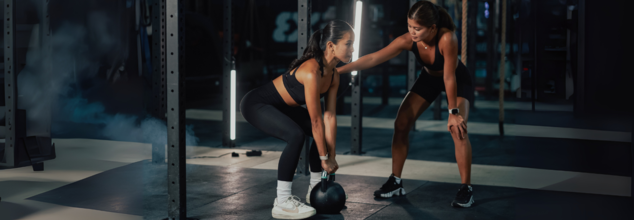- Health Conditions A-Z
- Health & Wellness
- Nutrition
- Fitness
- Health News
- Ayurveda
- Videos
- Medicine A-Z
- Parenting
- Web Stories
Unsure About Strength Training? Fitness Experts Share Methods That Might Fit You Best

Credits: Canva
If you're curious about building strength but don't know where to start, you're among the millions looking for the right exercise that suits their body and helps build strength. Strength training is not only for athletes or gym rats; it's a wonderfully versatile type of exercise that can accommodate all ages, fitness levels, and objectives. From wanting to add muscle mass, strengthen bones, alleviate stress, or simply haul groceries without aggravating back pain, strength training can assist—and it doesn't need to be convoluted.
Strength training isn't solely for gym rats or bodybuilders—it's a science-proven type of exercise that works for almost every system in the human body. The CDC states that adults need to do muscle-strengthening exercises at least two times per week to enhance health and lower the risk for chronic disease. Studies by the American Heart Association indicate that regular strength training enhances cardiovascular health, promotes healthy blood pressure, and helps regulate blood sugar. In addition to physical improvements, strength training has also been tied to improved mental health, mind function, and overall quality of life. Discover a approach that suits your lifestyle, fitness level, and goals.
Free Weights
Free weights such as dumbbells, barbells, kettlebells, and medicine balls provide unparalleled versatility. They more accurately reproduce daily movements than equipment and involve the use of multiple muscle groups, including stabilizers, to enhance balance and coordination.
They provide a natural range of motion and can be modified for every level of skill. Newbies can begin with light weights and progress slowly. It's all about learning proper form. For beginners, it's best to take advice from a certified trainer or coach to prevent injury and gain confidence.
Weight Machines
Weight machines are a great entry point if you’re new to strength training or recovering from an injury. These machines guide your movements, offering a fixed range of motion that lowers the risk of doing an exercise incorrectly.
They enable you to target individual groups of muscles and are less scary than free weights. They also facilitate easier resistance control, which is perfect for individuals starting to build their strength.
Resistance Bands
If you are an avid traveler or like to work out at home, resistance tubes or bands are a budget-friendly and space-saving option. There are different tensions for these elastic bands, and they can be utilized to work virtually every part of the body.
From leg presses to shoulder rotations, bands are ideal for enhancing flexibility, balance, and tone. They're also less prone to injury, so they're perfect for seniors or anyone just getting into fitness.
Bodyweight Exercises
Pushups, squats, lunges, planks, and pullups are all included. Bodyweight exercises are highly effective and don't need much to no equipment, making them one of the easiest forms of strength training.
They depend on the resistance of your body to provide functional strength directly usable in daily life. They are simple to modify to make them more or less intense based on your skill level.
Why Strength Training Is Necessary?
Strength training's advantages extend way beyond adding bulk:
Muscle Retention: As we get older, we naturally lose muscle. Strength training will keep it intact, keeping us strong and mobile longer.
Bone Health: Weight lifting increases bone density and decreases the risk of osteoporosis.
Joint Support: It aids in the management of arthritis by enhancing joint function and decreasing pain.
Heart Health: Strength training on a regular basis can decrease blood pressure and enhance cholesterol.
Weight Management: It aids in maintaining lean muscle mass during weight loss and enhancing body composition.
Daily Functionality: From carrying groceries to walking upstairs, strength training makes daily activities easier.
Mental Health: Strength training can decrease anxiety, enhance mood, and increase self-esteem.
Cognitive Function: New studies connect frequent resistance training with improved memory and more acute thinking ability.
Begin with what makes you feel comfortable, and take it from there. You don't necessarily have to lift weights or get a gym membership immediately. Proper form and consistency are the most important things. Two to three strength training sessions a week are what experts suggest, allowing your muscles to rest in between.
Don't be shy to switch it up. Use equipment at the gym, have dumbbells at home, bring resistance bands on the road, and squeeze in some bodyweight circuits when there isn't time for more.
Strength training is not a cookie-cutter plan. What's important is selecting a strategy (or combination of strategies) that suits your lifestyle, style, and objectives. With the proper strategy, you can gain strength that benefits every aspect of your life—improved health to a more solid head.
Irrespective of how old you are or how fit you are, it's an excellent time to begin. Your body—and mind—will be grateful.
Should Women Try This 'Gym Bro' Supplement To Help Boost Focus, Mood And Memory?

Credits: Health and me
If you’ve ever dismissed creatine as just another muscle-building supplement for bodybuilders and gym bros, here’s a wake-up call: science is rewriting that script. Although Dwayne "The Rock" Johnson may still be spiking it into his post-gym smoothies, a previously unexpected new population is on to creatine—middle-aged women, health-conscious enthusiasts, and even professionals seeking to enhance cognitive function. Ivanka Trump breezily discussed it in her smoothie regimen, and TikTok is filled with users raving about its mood and mental performance benefits but let's get past anecdote. What is the science really suggesting?
What Is Creatine?
Creatine is a naturally occurring substance, synthesized primarily by the liver, kidneys, and pancreas, and also produced in muscles and the brain. We also obtain trace amounts from animal foods like red meat and fish.
The typical individual produces approximately one gram of creatine per day, but the optimal dose for maximum benefit is three to five grams daily—so most, particularly women (who tend to consume less meat), don't notice.
Creatine's first and foremost function is to assist in the regeneration of ATP, the molecule behind everything from bicep curls to brain activity. Until recently, its fame did not extend beyond the doors of the gym. Today, however, scientists are learning it could have applications in cognitive health, mood stabilization, and even disease prevention.
Cognitive and Mental Health Benefits of Creatine
Perhaps one of the most persuasive discoveries in recent years is the effect of creatine on the brain.
Creatine aids energy metabolism within the brain, which is essential in sustaining attention, memory, and emotional control—most especially during stress. A number of studies demonstrate that supplementation with creatine can decrease brain fog and fatigue and improve working memory.
In one study, conducted by the University of Kansas Medical Center, creatine supplements were linked to enhanced executive function and memory in Alzheimer's patients. In another study, individuals with depression who received a supplement of creatine along with cognitive behavioral therapy were found to have improved more quickly than those receiving therapy alone.
The link? Low levels of creatine have been correlated with decreased brain energy and neurotransmitter activity—factors that affect everything from mood to choice.
Why Women Might Gain Even More
Now comes the interesting part: women generally have lower creatine levels than men, both because they have less muscle mass and due to dietary habits. Studies show that hormonal changes—particularly during menstruation, pregnancy, and menopause—might also influence how creatine is synthesized, transported, and stored.
Menstruation and menopause, when estrogen levels are low, also make women susceptible to fluctuations in energy, muscle function, and mood. Creatine can level out these dips. It's also been found to lower muscle loss and help keep bones strong—something important for women as they grow older.
In one 12-month trial, postmenopausal women who took creatine supplements maintained better bone mineral density than those who didn't.
Early research also indicates that creatine may be involved in pregnancy complications. Evidence indicates that lower levels of maternal creatine are linked with increased stillbirth, premature birth, and reduced birth weight. Though supplementation is not yet routine or even proven safe, scientists are taking particular interest.
Interestingly, researchers have also calculated how much creatine infants would require—about 7–8.4 mg a day based on age—even though breast milk contains only a small proportion of that amount.
And then there's long COVID: women are more susceptible to it, and researchers think that variations in creatine metabolism could help explain why, in part. Since creatine helps with cellular energy, it could aid in alleviating fatigue and brain fog in long COVID patients.
As cognitive and hormonal benefits are hogging the limelight, the traditional muscle benefits of creatine haven't disappeared.
Creatine is a performance powerhouse for physical activity—particularly for short durations of high-intensity exercise. Research indicates it can enhance strength, endurance, and recovery, making it perfect not only for bodybuilders but also for anyone concerned with age-related muscle loss (sarcopenia). Approximately 5% to 16% of adults aged over 65 suffer from sarcopenia, and creatine has the potential to counteract this.
It also increases intracellular water in muscle cells, which increases hydration and muscle mass. That's why other users become bloated—a normal but normally harmless side effect.
How Much Creatine Is Enough?
General health requires 3–5 grams daily according to most experts. Creatine monohydrate is still the standard: it's the most researched, most affordable, and most bioavailable variety.
One scoop (roughly 5 grams) mixed into water or a smoothie is enough for most people. What matters most is consistency—it takes a few weeks for the body to fully saturate its creatine stores.
When to take it? Research is still mixed. Some prefer post-workout, others in the morning. The key is regularity rather than timing.
Is Creatine Safe for Everyone?
For healthy adults in general, creatine is very safe when used as directed. But it's not suitable for everybody.
It should be avoided by individuals with kidney disease or a history of kidney transplant. There are also problems for individuals who have bipolar disorder. Creatine is filtered through the kidneys, and in exceptional instances, has been connected to liver stress.
It's not yet indicated in pregnancy or lactation for a lack of definitive safety studies. Always consult a healthcare professional before supplementation—particularly if you're on drugs or dealing with chronic illness.
A just-released study that included 25,000 adults aged over 52 discovered a convincing association: each 0.09-gram boost in creatine consumption corresponded with a 14% reduced risk of cancer.
While preliminary and not definitive, this contributes to a steadily expanding list of possible advantages, such as antioxidant activity, improved mitochondrial function, and even possible tumor-inhibiting effects in animal models.
Creatine is experiencing a renaissance—and not only among jocks. With increasing evidence validating its cognitive function benefits, mental health benefits, bone mineral content benefits, and hormone regulation benefits, creatine is becoming an all-around staple beyond the weight room.
It's not just about gaining muscle anymore. It's about fueling total-body vitality, brain resilience, and optimal long-term health.
If you're a woman going through hormonal shifts, a senior looking to remain resilient, or anyone interested in brain wellness, creatine may be worth reconsideration.
Lift First, Run Later? The Best Workout Order For Maximum Fat Loss And Strength

(Credit-Canva)
Should you do cardio or weights first? All gym goers have been faced with this choice one too many times. Some prefer doing weights before they hit the cardio machines, while others try to get over it before. But is there a better option of the two?
New research suggests you might want to hit the weight room before you hop on the treadmill, bike, or elliptical.
A study published in April in the Journal of Exercise Science and Fitness investigated how the order of cardio and resistance training might impact health and fitness. The findings showed that participants who did strength training before cardio had "remarkable progress" in physical activity, fat loss, and muscular strength and endurance. But does this mean lifting weights before cardio is always the optimal choice?
What Happens When You Do Cardio After Weights, and Vice Versa?
In the study, researchers had a group of young men who were overweight or obese try different workout orders. They split the men into three groups:
- One group lifted weights, then did cardio.
- Another group did cardio, then lifted weights.
- The third group didn't do any structured exercise.
The groups that exercised worked out three times a week for an hour each session, over three months. Both exercise groups did 30 minutes of cardio and 30 minutes of strength training; only the order was different. Experts noted that a good point of the study was that both groups followed the same workout plan, which helped keep things fair.
Before, during, and after the study, researchers checked everyone's activity levels, body fat, muscle strength, and heart fitness. The results showed that both exercise groups improved in:
- How active they were
- Their body composition (less fat, more muscle)
- Muscle strength
- Heart and lung fitness
These results suggest that lifting weights before cardio is the best if you want to improve these specific things. However, a point noted was that the group that did cardio first still saw "very good" improvements that are good for health.
How Your Workout Order Affects Your Body?
Generally, the order of your workout matters because of how each type of exercise makes you tired. Doing cardio first can make you tired, meaning you might not have enough energy to put your full effort into lifting weights. Research supports this, showing that intense cardio before weights can reduce your strength endurance.
When you lift weights first, you're likely able to do your strength training with your best energy and focus. This might explain why the group that lifted weights first in the study spent more time training at higher intensities. This order could be ideal for people looking to build muscle or lose weight.
However, doing cardio before lifting weights also has benefits, especially if you're trying to improve your cardio endurance and heart and lung health. It allows you to put your best effort into your cardio sessions, which can be helpful if that's something you struggle with.
How to Build the Best Workout Routine for You?
When planning your workouts, think about your main goals. Start with whichever type of exercise—strength or cardio—you want to prioritize and improve the most. Just make sure you don't skip either type of training. Both are important for improving your health and fitness and should be a regular part of your exercise routine.
Also, changing up your workout order occasionally can help your body adapt to new challenges, further improving both muscle and heart fitness. Ultimately, remember that simply doing either cardio or weight training will help you improve muscle strength, bone density, heart endurance, and fat loss.
Most people prefer to lift weights followed by cardio, and more studies support the benefits of this order. But the most important thing is to find what works for you, and the health benefits will follow.
UK-based Reporter Tried The One Exercise Loved By Meghan Markle, Kardashians, And Hailey Bieber - Here's How It Went For Her

Credits: Wikimedia Commons and Instagram
Lagree Pilates has fast become the go-to workout for Hollywood A-listers, drawing the likes of Meghan Markle, Kim and Khloe Kardashian, and Hailey Bieber. Touted as a game-changer in strength and endurance training, Lagree combines elements of traditional Pilates with high-intensity, low-impact resistance exercises. Unlike the more familiar Reformer bed used in standard Pilates, Lagree is performed on a Megaformer—a machine specifically designed to target core strength, muscular endurance, balance, and flexibility all at once.
While the Megaformer has yet to become mainstream across all UK cities, Re:Sculpt studios in Manchester’s Ancoats and Salford offer a close alternative: the Maxformer, reports the Express UK. These machines mimic the design and intensity of Lagree’s original equipment, and their popularity is catching on quickly among fitness enthusiasts.
The Workout: More Sweat, Less Impact
Lagree Pilates sets itself apart by fusing strength training with cardio and balance-focused movements in a continuous flow, meaning minimal rest and maximum burn. It's often described as the “next level” of Pilates—great for building lean muscle, especially in the core, with little strain on joints. This makes it appealing not just for aesthetics but also for sustainable, long-term fitness.
The Experience: Pushing Past Limits
Isobel Pankhurst, a reporter with Express UK, decided to try the Maxformer class at Re:Sculpt’s Ancoats studio. Despite being no stranger to Reformer Pilates, she approached the session with caution. Upon arrival, she was greeted with a motivational quote—“So tough, but unreal!”—and a glass of citrus electrolytes, a detail that immediately made her second-guess her decision. After all, she’d never been handed electrolytes before a workout. What exactly was she in for?
The class, called Re:Tread, merges two formats: half the time on the Maxformer bed, and the other half on a treadmill. Each day alternates between focusing on upper or lower body, and Pankhurst’s visit landed her in an upper-body session.
The Maxformer, she quickly discovered, was not just a souped-up Reformer. It demanded far more in terms of strength and balance. The moves challenged her core and coordination, and even with prior Pilates experience, she found herself struggling. That said, the intensity also brought satisfaction. “It was so much more difficult than a Reformer,” she admitted, “but I did enjoy trying it out and will definitely return.”
The Treadmill Trials
After 20 sweat-drenched minutes on the Maxformer, the second half of the session moved to the treadmill. As someone who rarely runs—unless late for a train—Pankhurst dreaded this portion. “I’m not a fast runner,” she confessed, keeping her settings at a gentle jog while others sprinted full force. Still, she viewed it as a step above lazing in front of the TV and pushed through.
The Aftermath: Sore, but Satisfied
By the end of the hour-long session, she was wiped out and ready for a shower, but not before grabbing a protein shake to help recover. The next day came with the expected soreness, but also a sense of accomplishment. “It was tough,” she said, “but worth it. That quote of the month really was spot-on.”
So while the Maxformer may not be for the faint of heart, it’s certainly a full-body challenge worth considering—especially if you’re curious about what keeps Meghan and the Kardashians in shape.
© 2024 Bennett, Coleman & Company Limited

